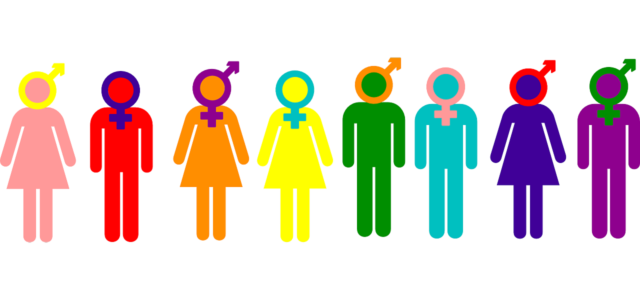Gender Theory

“Sexism masquerading as theology” is what I’ve always said about the church’s position on women’s ordination, and I see no reason to modify my position based on the new document from the Vatican Congregation for Catholic Education, which presents itself as a “Path of Dialogue.”
“Male and Female He Created Them” is a really useful summary of papal teaching on gender and sexuality. All the sources cited are from popes (before and after elevation) and other official documents and pronouncements. I am unfamiliar with many, especially those about education. The most startling take-away for me is how much Pope Francis is invested in this theology. I know I objected to some sections of Amoris Laetitia; seeing it quoted again and again, along with various letters and lectures, is deeply disappointing.

If you want to review this teaching, read this document. It takes about an hour and is unusually well-written and accessible. But critiquing “gender theory” based on what popes have written about it is contrary to every academic bone in my body. What about the original sources? Whose “gender theory,” specifically?
The document is in response to an “educational crisis,” but I would argue that it is a crisis of the Vatican’s own making, and it will have dire consequences for many people. If you’ve followed the response, you know that the document denies the validity of transgender as a concept (ideology) and as an experience. I fear most for transgender children in Catholic families and Catholic schools. Despite its recognition of the primacy of families in the education of their children, the document stresses that schools need to teach this damaging theology. Some of the awkwardness is expressed in my favorite paragraph, which comes at the point in the document when the use of “man” has begun to gag:
40. The Catholic school should be an educating community in which the human person can express themself and grow in his or her humanity, in a process of relational dialogue, interacting in a constructive way, exercising tolerance, understanding different points of view and creating trust in an atmosphere of authentic harmony.
Oh, you are trying so hard to not offend! But will we find this harmony in a Catholic school for a trans child, or a queer child, for whom I also fear. Or the children of LGBTQ parents. How are these children to express their lived “humanity’? Later you say “girls and boys” are called, rather, “to overcome their individualism, and discover, in the light of faith, their specific vocation to live responsibly in a community with others,” quoting a 1977 document on Catholic schools. Is this not crazy-making, for the school, the child, the parents, the teachers?
To be fair, that same paragraph says “The school must respect the family’s culture,” quoting Educating to Intercultural Dialogue in Catholic Schools: Living in Harmony for a Civilization of Love, a document from 2013. Folks, it is a lot easier to harmonize Spanish or Haitian or other immigrant and refugee students than to acknowledge this new culture that will be coming into your schools, children of faithful Catholic parents.
You get the gist. Maybe another day I’ll list some other specific points of disagreement. I want to quote some other responses, first from WOC on Facebook: “We stand in solidarity with the LGBTQIA+ community – who are made in the image and likeness of God, and who deserve a Church that stands with them in solidarity, love, and practical support against the real danger and discrimination they continue to face.”
Francis DeBernardo from New Ways Ministry says, “The document associates sexual and gender minorities with libertine sexuality, a gross misrepresentation of the lives of LGBT people which perpetuates and encourages hatred, bigotry, and violence against them.” Robert Shine continues the discussion by posting the results of a Public Religion Research Institute study that is optimistically titled “ New Poll Shows U.S. Catholics Are Increasingly Supportive of Transgender Rights.” Deacon Ray Dever of St. Paul Catholic Church, Tampa, Florida, writes about his experience – and wide speaking in Catholic venues – as the parent of a transgender daughter.

Marianne Duddy-Burke of DignityUSA responds: “It feels especially cruel and insensitive for this statement to be released as people all over the world are marking the 50th anniversary of the Stonewall rebellion, a pivotal moment in the LGBTQI movement for visibility, respect, and equality. For the Vatican to depict the courage, struggle, and sacrifice of so many individuals and families as an effort to destroy the concept of gender and destabilize families is not merely personally hurtful to countless people. It also has potentially dangerous consequences for LGBTQI people all around the world, by giving justification to those who see us as inherently threatening and frequently resort to violence against us.”
DignityUSA’s Dateline includes links to coverage in The Washington Post, NBC, UPI, The Daily Caller, The Boston Globe and in radio outlets PRI, State of Belief and Radio.com.
Note that The New York Times is not included in this list. The perpetually-calm James Martin, SJ, writes a response there that is expanded in America, urging the Vatican to dialogue with actual transgender people. David Cloutier takes on gender theory by examining the assumptions of both the LGBTQ movement’s and the Vatican’s framing of the issue of “born this way” versus self-discovery of gender identity through experience. Read it when you’re calm.
Finally, Joshua McElwee does the good journalist’s job in NCR by providing examples of how Francis is more pastoral when engaging with individuals than speaking or writing theoretically. His summary highlights all the points I would raise if I wanted to write more.
I am sure I don’t need to spell out for you how damaging this document is to women as well. We must stand up for all people and challenge this teaching at every turn.

4 Responses
The document calls for dialogue, which is good, but I suspect it is yet (unconsciously?) another defense of religious patriarchy and the exclusively male priesthood. Surely they know that patriarchal gender theory (i.e., male headship, gender binary) is also a “gender theory”? Some points about this confusing document:
— Nothing about patriarchy being a gender theory
— Implicit assumption that patriarchy is natural
— Too much about difference, complementarity
— Very little about unity, same flesh, communion
— Conflation of sexual identity and gender identity
— Conflation of body, sex, gender, person
It seems clear to me that, for doctrinal development pursuant to the ordination of women, dismantling patriarchal gender theory remains a top priority. The best way to do it is by turning the “Theology of the Body” inside out and show that corporality (i.e., being a body-person) is integral to apostolic tradition; masculinity, not so. We celebrate “Corpus Christi,” not “Vir Christi.” The church is “one, holy, catholic, and apostolic,” but not necessarily patriarchal. The dogmatic definition on the institution of the priesthood of the New Law (Trent) does NOT mention a masculinity requirement for ordination and apostolic succession. The ordination of women to the priesthood and the episcopate would be in perfect continuity with apostolic tradition.
I really like your insistence that patriarchy is really a gender theory, one of many. It is the one that has been accepted, enshrined and protected for centuries in Western civilization, but not universally, and hopefully, not forever.
I wish a contigent from WOC could march in solidarity with the Trans march coming up in two weeks in SF! Trans people from Catholic backgrounds must be among the most isolated
people in the world!
Pope Francis does seem invested in this theology, but I definitely question his involvement in the creation of this document. I would read into the absence of his signature (and the fact that the Dicastory is soon being eliminated in the new curial reforms)… but that doesn’t stop the violent consequences of the language.